Abstract
In view of the lateral and vertical vibration problem of car body in actual operation, dynamic simulation and relevant line tests are carried out to study the impact of lateral damper on the ride quality. To facilitate comparative analysis, dynamic models of metro vehicle are set up and simulation results indicate that ride quality when using a single lateral damper is better than when using double dampers. On this basis, line comparison tests are conducted, with ride index in time domain as an indicator. Acceleration sensors are utilized to conduct lateral and vertical acceleration tests when using a single lateral damper and double dampers, respectively. Ride index of every 5 seconds at normal operating velocity is obtained after post-processing of data collected from the tests. Comparison of ride index of two adjacent stations obtained by statistics has found that, in actual operation, metro vehicle with a single lateral damper mounted on the bogie has a better ride quality both laterally and vertically than that with double dampers. Single lateral damper model can also effectively solve abnormal vibration problem of the metro vehicle.
1. Introduction
To guarantee the ride quality and comfort of metro vehicles, lateral dampers are widely installed to connect bogie and car body almost in all metro vehicles to decrease lateral movement and yaw motion of the car body relative to bogie. Besides, lateral dampers also affect the vertical movement of the car body to some extent [1, 2]. Usually, every bogie has one or two lateral dampers, the working effect of which are decided by the arrangement method and damping parameters. There are mainly three arrangement methods: double symmetrical or inclined symmetrical arrangement method as well as unilateral arrangement method [3]. Studies have shown that, compared with arrangement method, damping parameters exert a greater effect on the ride quality [4]. Damping parameters can restrain the vibration displacement between the car body and bogie, but are likely to increase the vibration acceleration of the vehicle in free space [5].
Domestic and foreign scholars have carried out a lot of researches on damping characteristics, working principle and impact of dampers on the dynamic performance of the metro vehicle. Richard et al. have set up a numeric model of a fluid damper by researching its working characteristics and mechanical parameters of its internal structure [6]. Yang et al., aiming at a better ride quality, have optimized the design of the primary vertical damper valve of high-speed passenger train without changing parameters of other vehicle parts, based on an equivalent linear model of fluid damper subject to random vibration [7]. Dragan et al. have studied the impact of vertical suspension stiffness and dampers on the ride quality of the car body by conducting optimization analysis of spring stiffness and damping with vertical vibration transfer function and power spectral density, according to statistical dynamic equations in the frequency domain [8, 9]. Xu et al. have researched the impact of variable magnetorheological (MR) damper on vehicle’s lateral stability. They establish a Bouc-Wen model according to the characteristics of MR damper, put it to application and come up with methods of improving the lateral stability with this model through simulation analysis [10, 11]. Cui et al. have conducted dynamic simulation analysis of high-speed vehicle damper by utilizing its vibration isolation characteristics and optimized damper parameters so as to verify their rationality [12, 13]. In summary, simulation studies on the working characteristics and parameters of vibration isolation dampers have been quite mature. However, these studies are mostly theoretical and rarely come to the practical application in specific vehicles, and thus lack the verification of comprehensive line tests, particularly when it comes to the tests concerning the impact of secondary suspension lateral damper on the ride quality in actual operation.
A certain domestic metro vehicle has quite obvious lateral vibration problem in actual operation, accompanied by yaw motion of the car body. According to preliminary assessment, it must have something to do with the damping setting of the dampers mounted on the bogie. For this vehicle, every bogie has two symmetrically placed lateral dampers, each with a damping value of 60 kNs/m. This paper, taking ride index as evaluation standard, together with the secondary suspension lateral damper arrangement method and damping values, endeavors to analyze the impact of lateral dampers on the ride quality through dynamic simulation and line tests.
2. Dynamic model
According to the actual structure and suspension parameters of the metro vehicles, a dynamic model is set up, as shown in Fig. 1. This model consists of rigid bodies including a car body, two bogies, four wheelsets, two linear motors, fourteen linear motors hanger rods and so on, connected through force element. Wheelsets use TB LM1967-87 type tread and 60 kg/m rail, with rolling circle radius of 0.365 m, rail cant of 1:40 and gauge of 1435 mm. As for lateral dampers, a double symmetrical arrangement method is adopted. Due to this symmetrical arrangement, reducing the damping value by half can be achieved by reducing one of the parallel dampers in actual operation. In simulation, U.S. Grade 5 Track Irregularity Spectrum, which resembles the actual situation, is adopted as input.
To facilitate comparison of the simulation results and the actual line test results, particularly the condition of the bogie when using a single lateral damper and two dampers, respectively, a single lateral damper dynamic model and two lateral dampers dynamic model are set up. The two models are identical except for the number of lateral dampers mounted on each bogie.
Fig. 1Dynamic model of metro vehicle
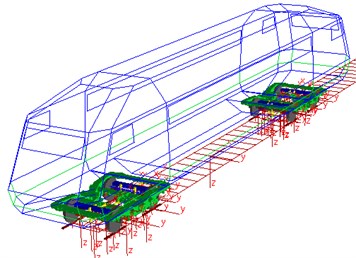
3. Dynamic simulation results
Both the damping value and arrangement method of lateral dampers affect lateral and vertical stability of metro vehicle. Based on the above-mentioned two models, this paper takes the lateral and vertical stability of both the front and rear end of car body as evaluation standards. Ride index W for railway vehicles in China is calculated according to Sperling Index [14].
In accordance with the vehicle ride quality rating, as shown in Table 1, the same rating applies to both the lateral and vertical stability. The lateral and vertical stability of the ends of car body are compared when the vehicle is running at different velocity on straight lines of different regularity states according to U.S. Grade 5 Track Irregularity Spectrum.
Simulation results are shown in Fig. 2 and Fig. 3, in which Fig. 2(a) and Fig. 2(b) indicate the lateral stability of the front and rear end of the car body, while Fig. 3(a) and Fig. 3(b) indicate the vertical stability of the front and rear end of the car body, respectively.
Table 1Vehicle ride quality rating in China
Rating | Ride index |
Excellent | W<2.5 |
Good | 2.5<W<2.75 |
Qualified | 2.75<W<3 |
Fig. 2Comparison of lateral stability of the front and rear end of the car body
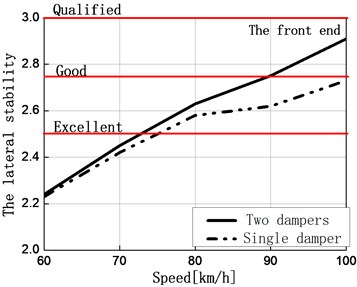
a) The front end
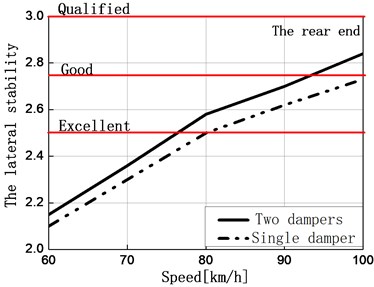
b) The rear end
Fig. 3Comparison of vertical stability of the front and rear end of the car body
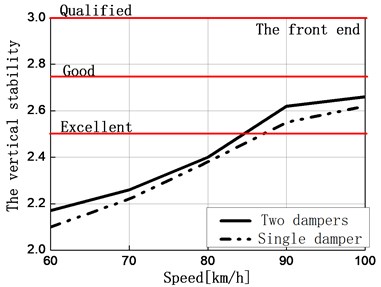
a) The front end
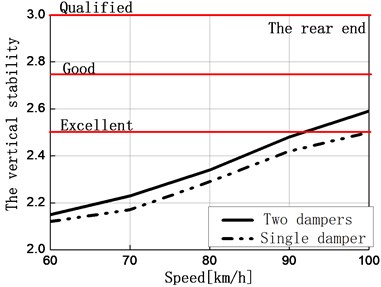
b) The rear end
It can be seen that within the velocity range from 60 km/h to 100 km/h, ride index increases as the velocity increases, and index is better when using a single lateral damper than when using double dampers. In all velocity, the stability simulation results of the front and the rear end are consistent and better when using a single lateral damper.
Dynamics Simulation results show that from the perspective of improving ride quality of metro vehicles, halving the damping value by adopting a single lateral damper arrangement method is truly conducive. This model can also effectively reduce the negative effects caused by excessive damping.
4. Test results analysis
Working condition 1 indicates the ride index test result of metro vehicle with double dampers after wheel reprofiling in 6 months while working condition 2 shows that of vehicle with a single damper. Two typical intervals are selected and the comparison of their ride index is shown in Fig. 4 and Fig. 5, respectively. The two figures indicate the comparison of lateral stability at the interval from the 12th station to 13th station and of vertical stability at the interval from the 6th station to 7th station. Velocity curve of the two tests within the same time interval are almost identical, thus indicating the running performances under the two working conditions are the same, the ride index tests are highly reproducible and test results highly comparable. From the perspective of ride index revealed in the comparison figures, the ride index line chart is closely related to velocity and its overall trend is consistent with the increase or decrease of velocity. From the comparison of ride index line charts under two working conditions, it is found that ride index of the vehicle with a single damper is obviously lower than that with double dampers although ride index trends of the two intervals are the same. Seen from the maximum ride index, the lateral ride index turns from “good” in the 12th station to “excellent” in the 13th station while the vertical ride index turns from “qualified” in the 6th station to “good” in the 7th station. Both the overall index and maximum ride index reflect that ride quality of the vehicle with a single damper under working condition 1 is better than that with double dampers under working condition 2.
Table 2 is the statistical results of maximum ride index at each interval.
Fig. 4Lateral stability of vehicles in working condition 1 and 2
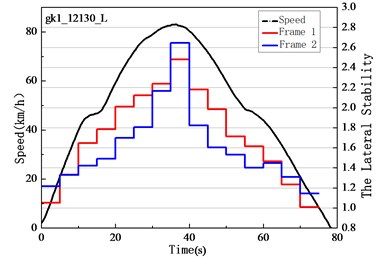
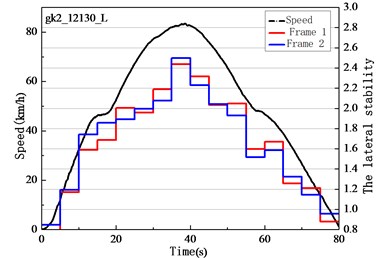
Fig. 5Vertical stability of vehicles in working condition 1 and 2
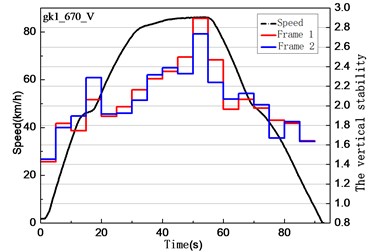
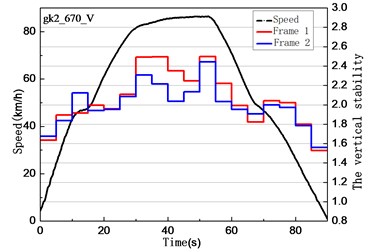
Table 2Statistical results of maximum ride index under working condition 1 and 2 (number)
Item | Excellent | Good | Qualified | Total |
Working condition 1 Lateral | 13 | 5 | 1 | 19 |
Working condition 2 Lateral | 16 | 3 | 0 | 19 |
Working condition 1 Vertical | 10 | 3 | 6 | 19 |
Working condition 2 Vertical | 10 | 8 | 1 | 19 |
Statistics show that in terms of lateral ride index, “excellent” index under working condition 2 accounts for a larger proportion; in terms of vertical ride index, “good” index under working condition 2 is significantly more than working condition 1. Therefore, the overall ride index under working condition 2, no matter vertical or lateral, is better than that under working condition 1. It follows that ride index of vehicle with a single damper is superior to that of vehicle with double dampers.
5. Conclusions
1) A dynamic model of a certain type of linear motor metro has been set up, through which it has been found the ride quality of metro vehicle has something to do the secondary suspension lateral damper in view of the excessive vibration of the car body in actual operation. The number of secondary suspension lateral damper has been optimized and ride quality of metro vehicle with a single damper is obviously superior to the original one with double dampers by comparing the lateral and vertical ride index, respectively;
2) Acceleration sensors have been used to test the lateral and vertical acceleration at each interval in actual operation. Acceleration signals have been converted into the lateral and vertical ride index of the vehicle. Results show that ride quality of metro vehicle with a single damper is superior;
3) Dynamic simulation and line tests have helped optimize the number of dampers of metro vehicles, and thus solve the excessive vibration problem in actual operation.
References
-
Wrang M. Instability phenomena of a passenger coach caused by internal yaw damper flexibility. Vehicle System Dynamics Supplement, Vol. 33, 1999, p. 406-417.
-
Li J. CFD Simulation for Train Hydraulic Damper. Doctoral Theses, Southwest Jiaotong University, 2012.
-
Huang Y., Li F., Fu M., et al. Influence of lateral damper place model over metro vehicle on dynamics performance. Urban Mass Transit, Vol. 8, 2010, p. 39-42.
-
Liu J., Wang K., Feng Q., et al. Influence of lateral damper on locomotive riding quality. Journal of Traffic and Transportation Engineering, Vol. 3, 2006, p. 1-4.
-
Chi Y., Lin J., Li Y., et al. Simulation study on influence of the secondary lateral damper coefficient on the lateral vibration of vehicles. Rolling Stock, Vol. 4, 2004, p. 15-17.
-
Kasteel R. V., Qian L., Wang C., et al. Study on working principle and numerical model of damper in railway vehicles. Journal of the China Railway Society, Vol. 2, 2005, p. 28-34.
-
Yang L., Pan S., Feng P. Optimization design of the variable damper main parameters based on the vehicle stationary model. Chinese Journal of Mechanical Engineering, Vol. 3, 2002, p. 99-103.
-
Stribersky A., Kienberger A., Wagner G., et al. Design and evaluation of a semi-active damping system for railway vehicles. Vehicle System Dynamics, Vol. 28, 1998, p. 669-681.
-
Sekulic D., Dedovic V. The effect of stiffness and damping of the suspension system elements on the optimisation of the vibrational behavior of a bus. International Journal for Traffic and Transport Engineering, Vol. 1, Issue 4, 2011, p. 231-244.
-
Xu Y., Ahmadian M., Sun R. Improving vehicle lateral stability based on variable stiffness and damping suspension system via MR damper. Vehicular Technology, Vol. 63, 2014, p. 1071-1078.
-
Liu Y., Matsuhisa H., Utsuno H., Park J. Controllable vibration of the car-body using magnetorheological fluid damper. International Journal of Vehicle System Dynamics Supplement, Vol. 41, Issue 4, 2004, p. 627-636.
-
Cui D., Li L., Jin X., et al. Influence of vehicle parameters on critical hunting speed based on Ruzicka model. Chinese Journal of Mechanical Engineering, Vol. 25, Issue 3, 2012, p. 536-542.
-
Li P., Goodall R., Weston P., et al. Estimation of railway vehicle suspension parameters for condition monitoring. Control Engineering Practice, Vol. 15, 2007, p. 43-55.
-
Liu Z. The Research on the Assessment Methodology of Ride Performance of Railway Vehicles. Doctoral Theses, Southwest Jiaotong University, 2007.
-
TB/T 2360-93. The identification method and evaluation standard for dynamic performance test of railway locomotives. 1993.
-
International Union of Railways. UIC513R guidelines for evaluating passenger comfort in relation to vibration in railway vehicles. 1994.
About this article
We thank the National Natural Science Foundation of China (Grant No. 51575458) for their aid and support
